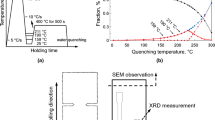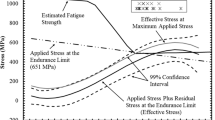Abstract
The effect of stress concentration geometry on the fracture behavior and fracture mechanisms of a two-step quenching and partitioning steel consisting of tempered martensite and retained austenite (RA) is investigated using double edge notched tension (DENT) specimens with different notch root radii. The initial notch opening is varied from a fatigue pre-crack to 15 mm radius. The fracture surface consists in flat triangular regions and slant zones. The fracture mode evolves from intergranular brittle fracture to ductile fracture with dimples. The ductile fracture process further changes from internal necking coalescence to a void sheet shear type coalescence when increasing the notch root radius. A similar transition of the fracture behavior is observed along the ligament of the DENT specimen. This change in the fracture mode results from a decrease of the stress triaxiality. The essential work of fracture is equal to \(40\hbox { kJ/m}^{{2}}\). This is small when looking at the large value of the product of ultimate tensile strength and total elongation (\(\sim 25, 000\, \hbox {MPa}{\cdot }\)%). The small fracture toughness is ascribed to an intergranular fracture mode, which results from the distribution of blocky RA islands along the boundaries of martensitic packets and from the large stress concentration near the notch tip. A proper control of both the amount and morphology of RA during microstructure design is thus essential to generate the best compromise between tensile properties and fracture toughness, and to avoid the relatively low toughness and more brittle failure observed when stress triaxiality increases.










Similar content being viewed by others
References
Allain S, Geandier G, Hell J-C, Soler M, Danoix F, Gouné M (2017) In-situ investigation of quenching and partitioning by High Energy X-Ray Diffraction experiments. Scripta Mater 131:15–18
Asserin-Lebert A, Besson J, Gourgues AF (2005) Fracture of 6056 aluminum sheet materials: effect of specimen thickness and hardening behavior on strain localization and toughness. Mater Sci Eng A 395:186–194. https://doi.org/10.1016/j.msea.2004.12.018
Bandstra JP, Koss DA (2001) Modeling the ductile fracture process of void coalescence by void-sheet formation. Mater Sci Eng A 319–321:490–495. https://doi.org/10.1016/S0921-5093(00)02007-4
Broberg K (1971) Crack-growth criteria and non-linear fracture mechanics. J Mech Phys Solids 19:407–418
Bron F, Besson J (2006) Simulation of the ductile tearing for two grades of 2024 aluminum alloy thin sheets. Eng Fract Mech 73:1531–1552. https://doi.org/10.1016/j.engfracmech.2006.01.024
Bron F, Besson J, Pineau A (2004) Ductile rupture in thin sheets of two grades of 2024 aluminum alloy. Mater Sci Eng A 380:356–364. https://doi.org/10.1016/j.msea.2004.04.008
Callahan M, Perlade A, Schmitt JH (2019) Interactions of negative strain rate sensitivity, martensite transformation, and dynamic strain aging in 3rd generation advanced high-strength steels. Mater Sci Eng A 754:140–151. https://doi.org/10.1016/j.msea.2019.03.042
Casellas D et al (2017) Fracture Toughness to Understand Stretch-Flangeability and Edge Cracking Resistance in AHSS. Metall Maters Trans A 48:86–94
Casellas D, Madivala M, Lara A, Calvo J, Cabrera JM, Prahl U (2014) Fracture and crack propagation resistance of High Manganese TWIP Steels: Experimental evaluation. In: International Conference on High Manganese Steel, Aachen, German
Chen S, Rana R, Haldar A, Ray RK (2017) Current state of Fe-Mn-Al-C low density steels. Prog Mater Sci 89:345–391
Cotterell B, Reddel J (1977) The essential work of plane stress ductile fracture. Int J Fract 13:267–277
Cotterell B, Pardoen T, Atkins A (2005) Measuring toughness and the cohesive stress-displacement relationship by the essential work of fracture concept. Eng Fract Mech 72:827–848
Faccoli M, Cornacchia G, Gelfi M, Panvini A, Roberti R (2014) Notch ductility of steels for automotive components. Eng Fract Mech 127:181–193
Fett T (2005) Influence of a finite notch root radius on fracture toughness. J Eur Ceram Soc 25:543–547
Frómeta D, Tedesco M, Calvo J, Lara A, Molas S, Casellas D (2017) Assessing edge cracking resistance in AHSS automotive parts by the Essential Work of Fracture methodology. J Phys Conf Ser 896:012102. https://doi.org/10.1088/1742-6596/896/1/012102
Gamez-Perez J, Santana O, Martinez A, Maspoch ML (2008) Use of extensometers on essential work of fracture (EWF) tests. Polym Test 27:491–497
Golling S, Frómeta D, Casellas D, Jonsén P (2018) Investigation on the influence of loading-rate on fracture toughness of AHSS grades. Mater Sci Eng A 726:332–341. https://doi.org/10.1016/j.msea.2018.04.061
Golling S, Frómeta D, Casellas D, Jonsén P (2019) Influence of microstructure on the fracture toughness of hot stamped boron steel. Mater Sci Eng A 743:529–539. https://doi.org/10.1016/j.msea.2018.11.080
Gutierrez D, Pérez Caro L, Lara A, Casellas Padró D, Prado Pozuelo JM (2013) Evaluation of essential work of fracture in a dual phase high strength steel sheet. Rev Metal 49:45–54
Hancock JW, Mackenzie AC (1976) On the mechanisms of ductile failure in high-strength steels subjected to multi-axial stress-states. J Mech Phys Solids 24:147–160. https://doi.org/10.1016/0022-5096(76)90024-7
James MA, Newman JC (2003) The effect of crack tunneling on crack growth: experiments and CTOA analyses. Eng Fract Mech 70:457–468. https://doi.org/10.1016/S0013-7944(02)00131-5
Kähkönen J, Pierce DT, Speer JG, de Moor E, Thomas GA, Coughlin D, Clarke K, Clarke A (2016) Quenched and Partitioned CMnSi Steels Containing 0.3 wt.% and 0.4 wt.% Carbon. JOM 68:210–214. https://doi.org/10.1007/s11837-015-1620-4
Lacroix G, Pardoen T, Jacques PJ (2008) The fracture toughness of TRIP-assisted multiphase steels. Acta Mater 56:3900–3913. https://doi.org/10.1016/j.actamat.2008.04.035
Lara A, Frómeta D, Molas S, Rehrl J, Suppan C, Casellas D (2016) Relation between stretch-flangeability and fracture toughness in advanced high strength steels. In: Proceedings of the IDDRG2016, Linz, Austria
Mahgoub E, Deng X, Sutton MA (2003) Three-dimensional stress and deformation fields around flat and slant cracks under remote Mode I loading conditions. Eng Fract Mech 70:2527–2542. https://doi.org/10.1016/S0013-7944(03)00082-1
Mahmoud S, Lease K (2003) The effect of specimen thickness on the experimental characterization of critical crack-tip-opening angle in 2024–T351 aluminum alloy. Eng Fract Mech 70:443–456. https://doi.org/10.1016/S0013-7944(02)00130-3
Mai Y, Cotterell B (1980) Effects of pre-strain on plane stress ductile fracture in \(\alpha \)-brass. J Mater Sci 15:2296–2306
Mai Y, Pilko K (1979) The essential work of plane stress ductile fracture of a strain-aged steel. J Mater Sci 14:386–394
Mai YW, Powell P (1991) Essential work of fracture and \(j\)-integral measurements for ductile polymers. J Polym Sci Part B Polym Phys 29:785–793
Marchal Y, Delannay F (1996) Influence of test parameters on the measurement of the essential work of fracture of zinc sheets. Int J Fract 80:295–310
Martin G, Yerra SK, Bréchet Y, Véron M, Mithieux JD, Chéhab B, Delannay L, Pardoen T (2012) A macro- and micromechanics investigation of hot cracking in duplex steels. Acta Mater 60:4646–4660. https://doi.org/10.1016/j.actamat.2012.03.040
Pardoen T (2014) Size and rate dependent necking in thin metallic films. J Mech Phys Solids 62:81–98. https://doi.org/10.1016/j.jmps.2013.09.006
Pardoen T, Marchal Y, Delannay F (1999) Thickness dependence of cracking resistance in thin aluminium plates. J Mech Phys Solids 47:2093–2123
Pardoen T, Hachez F, Marchioni B, Blyth P, Atkins A (2004) Mode I fracture of sheet metal. J Mech Phys Solids 52:423–452
Pineau A, Benzerga AA, Pardoen T (2016) Failure of metals I: Brittle and ductile fracture. Acta Mater 107:424–483. https://doi.org/10.1016/j.actamat.2015.12.034
Schindler HJ, Kalkhof D, Viehrig HW (2014) Effect of notch acuity on the apparent fracture toughness. Eng Fract Mech 129:26–37. https://doi.org/10.1016/j.engfracmech.2014.07.022
Takahashi Y, Kawano O, Tanaka Y, Ohara M, Ushioda K (2012) Analysis of governing factors of stretch flange-ability of hot-rolled high strength steels on the basis of fracture mechanics. Tetsu-to-Hagane 98:378–387. https://doi.org/10.2355/tetsutohagane.98.378
Tsuji K, Iwase K, Ando K (1999) An investigation into the location of crack initiation sites in alumina, polycarbonate and mild steel. Fatigue Fract Eng Mater Struct 22:509–518
Wang MM, Hell JC, Tasan CC (2017) Martensite size effects on damage in quenching and partitioning steels. Scripta Mater. 138:1–5. https://doi.org/10.1016/j.scriptamat.2017.05.021
Wu R, Li J, Li W, Wu X, Jin X, Zhou S, Wang L (2016) Effect of metastable austenite on fracture resistance of quenched and partitioned (Q&P) sheet steels. Mater Sci Eng A 657:57–63
Xiong Z, Jacques PJ, Perlade A, Pardoen T (2018) Ductile and intergranular brittle fracture in a two-step quenching and partitioning steel. Scripta Mater. 157:6–9. https://doi.org/10.1016/j.scriptamat.2018.07.030
Xiong Z, Jacques PJ, Perlade A, Pardoen T (2019) Characterization and control of the compromise between tensile properties and fracture toughness in a quenched and partitioned steel. Metall Mater Trans A 50:3502–3513. https://doi.org/10.1007/s11661-019-05265-2
Yang D, Xiong Z (2020) The dependence of fracture resistance on the size and distribution of blocky retained austenite-martensite constituents. Metall Mater Trans A. https://doi.org/10.1007/s11661-020-05698-0
Yoon JI, Jung J, Joo SH, Song TJ, Chin KG, Seo MH, Kim SJ, Lee S, Kim HS (2016) Correlation between fracture toughness and stretch-flangeability of advanced high strength steels. Mater Lett 180:322–326. https://doi.org/10.1016/j.matlet.2016.05.145
Acknowledgements
This work was funded by ArcelorMittal Global R&D Maizières Products in France. Z.P.X. thanks the “Beijing Institute of Technology Research Fund Program for Young Scholars”.
Author information
Authors and Affiliations
Corresponding author
Ethics declarations
Conflict of interest
The authors declare that they have no conflict of interest.
Additional information
Publisher's Note
Springer Nature remains neutral with regard to jurisdictional claims in published maps and institutional affiliations.
Rights and permissions
About this article
Cite this article
Xiong, Z., Jacques, P.J., Perlade, A. et al. On the sensitivity of fracture mechanism to stress concentration configuration in a two-step quenching and partitioning steel. Int J Fract 224, 101–116 (2020). https://doi.org/10.1007/s10704-020-00448-0
Received:
Accepted:
Published:
Issue Date:
DOI: https://doi.org/10.1007/s10704-020-00448-0




